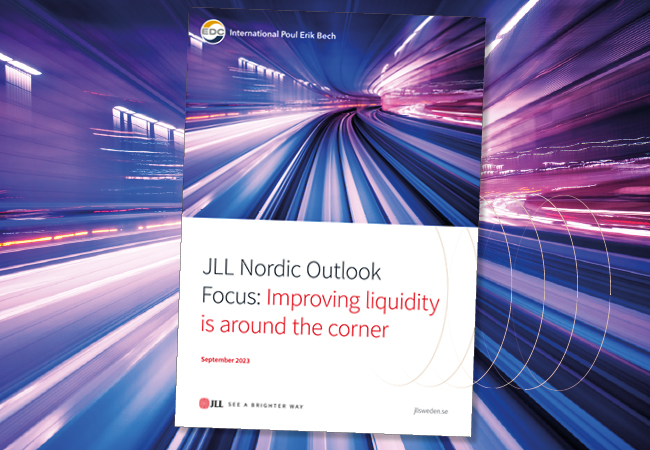JLL and EDC Poul Erik Bech with new Nordic Outlook: When does the Nordic real estate market trend turn?
JLL has recently released the report Nordic Outlook – Focus: Improving liquidity is around the corner, which assesses the state of the Nordic real estate market. The report delves into the office, logistics, retail, and investment markets in the Nordic countries, with EDC Poul Erik Bech contributing data, analysis, and commentary on the Danish part of the report. As the title suggests, this edition of the report focuses on the real estate market moving towards brighter times after a couple of challenging years.
However, Helle Nielsen Ziersen, Head of EDC International Poul Erik Bech, is not quite as optimistic: “Nordic Outlook provides a very good picture of the state of the Nordic real estate market, but one must also consider that Denmark differs in many aspects from the other Nordic countries. Denmark has not been affected by financing problems to the same extent as other countries, and our returns have not been as impacted as in other countries. Even though stability in the Danish market is a strong signal, ultimately, the bottom line attracts.”
Therefore, Helle Nielsen Ziersen believes that we will have to wait well into 2024 before seeing an increase in the number of transactions: “Even though Denmark has become a hotspot, many do not understand that the returns do not regulate in the same way as our Nordic neighbors. Therefore, I also believe that we will have to wait well into 2024 before we see an increase in the number of transactions.”
Stabilization of the Market
One of the key messages in the new Nordic Outlook report is to look forward to 2024 and assess when the real estate cycle will hit its bottom, and the market will start to move in the right direction.
Joseph Alberti, Head of Research at EDC Erhverv Poul Erik Bech, comments: “It’s no secret that transaction volume has fallen in 2023. The report shows that global transaction volume has dropped by nearly 50% compared to the third quarter of 2022. By comparison, transaction volume fell by an average of 64% at the peak of the great financial crisis in 2010, so these are significant numbers.”
“One of the most important messages in the report is the expectation of stabilization at the end of 2023 and a gradual improvement in liquidity in 2024. JLL’s global real estate confidence survey indicates that very few expect the market to worsen. Compared with the past, there is a tendency for the market to turn around after 4-5 consecutive quarters of downturn. Falling inflation will stabilize interest rates, and with the strong Nordic banks, there is hope that the market will stabilize, and transaction activity will pick up again,” says Joseph Alberti.
Helle Nielsen Ziersen, EDC International Poul Erik Bech, states: “In our international department, where we service foreign clients investing in Denmark, and Danish clients buying or especially renting premises abroad, we are also experiencing a decline in transactions. At the same time, there is a sense that many international investors in the country want Denmark. Still, they are a bit hesitant with the significant difference between Denmark and the Nordic neighboring countries. Therefore, I see a need for us to adapt to the markets in the Nordic region before we see an increase in the number of transactions again.”
Higher Yield Requirements and Interest Rates
The report identifies three fundamental factors indicating that the market is moving towards normalization and a turnaround. These factors are higher yield requirements, stabilization of long-term interest rates, and lower short-term interest rates. Joseph Alberti explains these factors:
“The higher yield requirements are obvious within the logistics and housing segments, which will likely encourage investors to become more willing to invest. The second factor is stabilizing long-term interest rates, which have been affected by a volatile world and fragile developments over the last six months. The expectation is that long-term interest rates will stabilize during the fall, creating renewed optimism among investors. The interest rate curve indicates lower short-term rates in the Nordics during 2024, but these are still higher than pre-crisis levels.”

